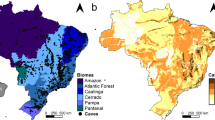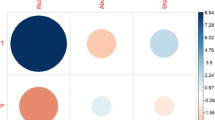Abstract
The isolated habitat of the Červené Blato bog (South Bohemia, Czech Republic) and its relict insect fauna have been the subject of long-term monitoring. The species composition and abundance of Lepidoptera (light traps) and Coleoptera (pitfall traps) were monitored for 4 years (1994–1997) simultaneously on two sites – in the edaphic climax pine forest and in wetland successional habitats. The method of statistical evaluation by RDA and CCA ordination, representing the habitat preference of species of Coleoptera (Carabidae only) and Lepidoptera (all nocturnal phototactic taxa) between the edaphic climax forest and succession stages, was used. All categories of the peatland taxa (tyrphobiontic, tyrphophilous and tyrphoneutral species) were analysed. Ten highly stenotopic tyrphobiontic species and 23 tyrphophilous species of Lepidoptera (out of 487) were most characteristic of the bog habitat. Only two tyrphophilous carabid species (out of 20) were characteristic of the bog. The most important relict species (tyrphobionts) of Lepidoptera are most diverse and abundant within the successional habitats and in the open wet forest. The relict fauna of the closed climax pine forest is much less diverse and composed mostly of abundant tyrphophilous and tyrphoneutral forest species. Preservation or restoration of sufficiently constant hydrological conditions, which prevents formation of the closed forest, is the basic management for habitat conservation of all relict tyrphobiontic species of the Červené Blato bog and similar peat land habitat islands. The peat bog is a unified complex system of specific diverse and relict taxa. The most specific taxa are tyrphobiontic Lepidoptera, but a number of other vulnerable tyrphophilous and tyrphoneutral insects are associated with the peat bog as well.
Similar content being viewed by others
References
Andersen, J. (1995) A comparison of pitfall trapping and quadrat sampling of Carabidae (Coleptera) on river banks. Entomol. Fenn. 6, 65–77.
Bezděk, A. (1998) Bionomické strategie střevlíkovitých bouků v izolovaných mokřadech. (Bionomical strategies of ground beetles in isolated wetlands.) Unpublished PhD thesis, Jihočeská Univerzita, České Budějovice (in Czech).
Březina, P. (1975) Lesní společenstva Třeboňské pánve (Forest communities of the Třeboň Basin.) Rozpravy ČSAV (Praha) 85(10), 1–116 (in Czech with English abstract).
Hůrka, K. (1960) Die Carabidenfauna des Sooser Moores in Westböhmen (Col., Carabidae). Acta Univ. Carolinae-Biologica 1960 (Suppl.), 59–82.
Hůrka, K. (1996) Carabidae of the Czech and Slovak Republics. Zín: Kabourek.
Jankovská, V. (1980) Paläogeobotanische Rekonstruktion der Vegetations-entwicklung im Becken Třeboňsképénev während des Spätglazials und Holozäns. Praha: Academia.
Jongman, R.H., Ter Braak, C.J. and van Tongeren, O.F.R. (1987) Data Analysis in Community and Landscape Ecology. Wageningen: Pudoc.
Karofeld, E. (1995) On the stability and succession of plant communities in bogs based on the botanical composition of peat. Scripta Botanica Tartu 9, 58–66.
Kasy, F. (1961) Bemerkenswerte wärmeliebende Schmetterlingsarten in schon bestehenden und projektierten Naturschutzgebieten im östlichen Österreich. XI. Int. Kongr. Ent. Wien 1960 Bd. 1, 519–25.
Klinger, L.F. (1996) The myth of the classic hydrosere model of bog succession. Arctic Alpine Res. 28(1), 1–9.
Krogerus, R. (1960) Ökologische Studien über nordische Moorarthropoden. Artenbestand, ökologische Faktoren, Korrelation der Arten. Soc. Sci. Fenn Comm. Biol. 21(3), 1–238.
Laštůvka, Z. (1994) Lepidoptera of the Protected Landscape Area Pálava. Brno: University of Agriculture.
Lavoie, C., Elias, S.A. and Filion, L. (1997) A 7000-year record of insect communities from a peatland environment, southern Québec. Ecoscience 4(3), 394–403.
Mikkola, K. and Spitzer, K. (1983) Lepidoptera associated with peatlands in central and northern Europe: a synthesis. Nota Lepid. 6, 216–29.
Moore, P.D. (1991) Ups and downs in peatland. Nature 353, 299–300.
Neuhäusl, R. (1972) Subkontinentale Hochmoore und ihre Vegetation. Stud. ČSAV (Praha) 13, 1–121.
Novák, I. and Spitzer, K. (1982) Ohroženýsvět hmyzu. (Endangered world of insects.) Praha: Academia (in Czech).
Peus, F. (1932) Die Tierwelt der Moore unter besonderer Ber¨ucksichtigung der europäischen Hochmoore. Handb. Moorkunde (Berlin) 3, 1–277.
Pop, E. (1964) Über die Herkunft der ombrogenen Moore und ihrer Flora. Ber. Geobot. Inst. ETH (Zürich) 35, 113–18.
Rektoris, L. (1994) Struktura tajgy Červeného blata. (The structure of taiga of the Červené Blato bog.). Unpublished MSc thesis, Universita Karlova, Praha (in Czech).
Roháček, J. and Máca, J. (1982) Acalyptrate Diptera of peat bogs in North Moravia (Czechoslovakia). Part 2. Čas. Slez. Muz. Opava (A) 31, 193–213.
Roubal, J. (1934) Die Coleopterenwelt (Tyrphobionte, Tyrphophile, Tyrphoxene, etc.) der Treboner (Wittingauer) Moore. Folia Zool. Hydrobiol. (Riga) 7(1), 56–97.
Spence, J.R. and Niemelä, J.K. (1994) Sampling carabid assemblages with pitfall traps: the madness and the method. Can. Entomol. 126, 881–94.
Spitzer, K. (1981) Ökologie und Biogeographie der bedrohten Schmetterlinge der südböhmischen Hochmoore. Beih. Veróff. Naturschutz Landschaftspflege Bad.-W¨urtt. 21, 125–31.
Spitzer, K. (1992) Biogeographical and ecological features of Central European peat bogs: the habitat island approach. IWRB Spec. Publ. 22, 17–18.
Spitzer, K. (1994) Biogeographical and ecological determinants of the central European peat bog Lepidoptera: the habitat island approach to conservation. Nota Lepid. 5 (Suppl.), 45–9.
Spitzer, K. and Jaroš, J. (1993) Lepidoptera associated with the Červené Blato bog (Central Europe): conservation implications. Eur. J. Entomol. 90, 323–36.
Spitzer, K., Jaroš, J. and Svensson, I. (1991) Geographical variation in food plant selection of Eupithecia gelidata Möschler, 1860 (Lepidoptera, Geometridae). Entomol. Fenn. 2, 33–6.
Spitzer, K., Jaroš, J., Havelka, J. and Lepš, J. (1997) Effect of small-scale disturbance on butterfly communities of an Indochinese montane rainforest. Biol. Conserv. 80, 9–15.
Tallis, J.H. (1983) Changes in wetland communities. In Ecosystems of the World 4A – Mires: Swamp, Bog, Fen and Moor (A.J.P. Gore, ed.) pp. 311–47. Amsterdam: Elsevier.
Ter Braak, C.J.F. (1987) CANOCO – a FORTRAN Program for Canonical Community Ordination. Wageningen: TNO Institute of Applied Computer Science.
Väisänen, R. (1992) Distribution and abundance of diurnal Lepidoptera on a raised bog in southern Finland. Ann. Zool. Fenn. 29, 75–92.
Author information
Authors and Affiliations
Rights and permissions
About this article
Cite this article
Spitzer, K., Bezděk, A. & Jaroš, J. Ecological Succession of a Relict Central European Peat Bog and Variability of Its Insect Biodiversity. Journal of Insect Conservation 3, 97–106 (1999). https://doi.org/10.1023/A:1009634611130
Issue Date:
DOI: https://doi.org/10.1023/A:1009634611130




